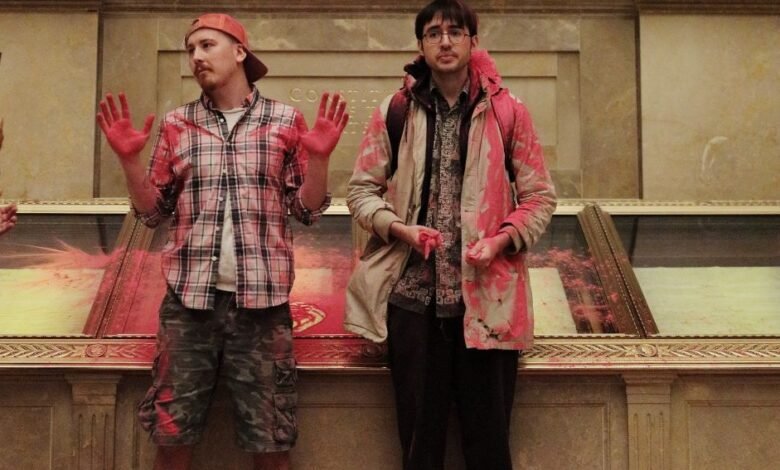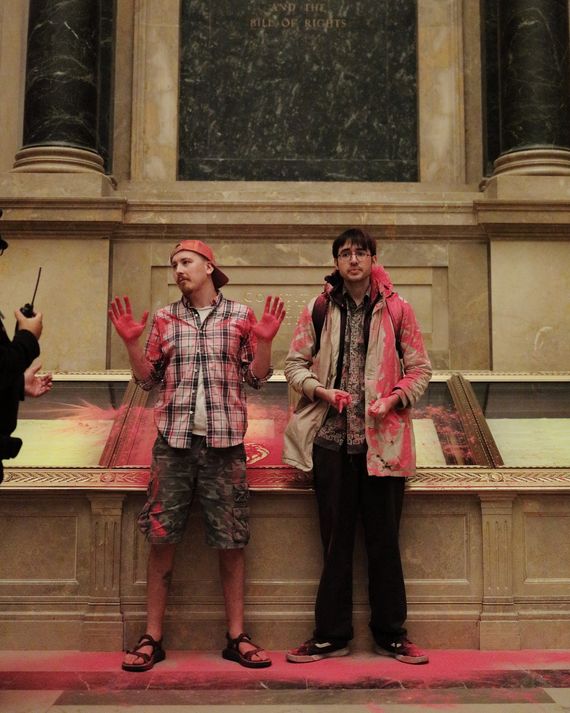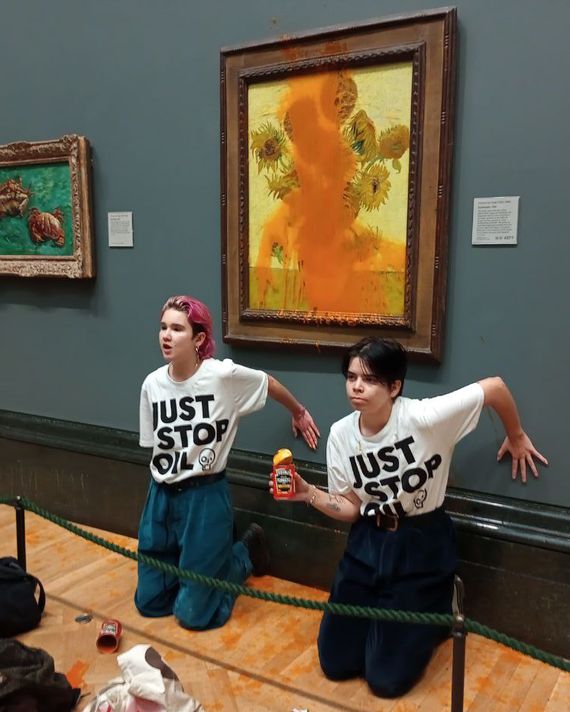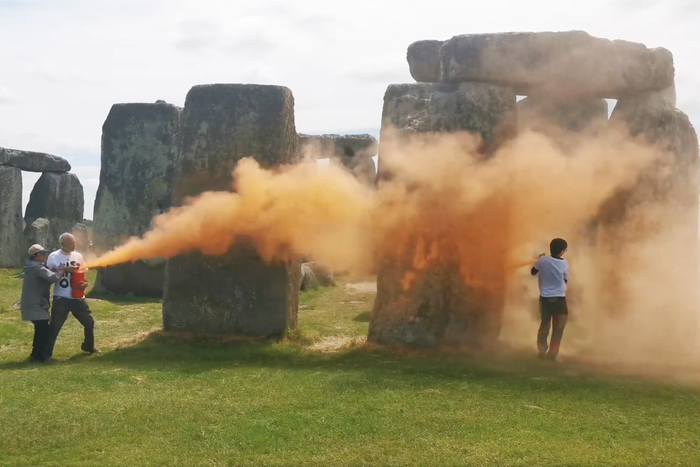

Kroegeor and Donald Zepeda in front of the U.S. Constitution, February 2024.
Photo: Will Dickson
The National Archives Museum in Washington, D.C., is secured by 40-foot bronze doors, each of which weighs 6.5 tons. On Valentine’s Day 2024, around 1 p.m., Donald Zepeda walked the mile there from his Airbnb to throw paint powder on the Constitution of the United States. He was 35. The parts per million of carbon in the atmosphere was 422.99. He had been arrested 20 times for civil disobedience, including the day before, when he and two others sat in the middle of the George Washington Parkway and demanded that President Biden declare a climate emergency.
Zepeda had dressed respectfully for the occasion: khakis, plaid button-down, gray anorak, black Vans. When he arrived at the archives, he walked to the bathroom, where he removed a small plastic bag of tempera paint powder from his backpack and placed it in his jacket pocket. In the bottle, the powder had looked red, like blood. Now, tied up in this flimsy bag, it looked like hot-pink CAUTION tape.
Zepeda felt, as he often did, anxious, tired, and slightly numb. He got scared about time — how little he, or anyone else, had to do good deeds. His philosophy for trying to save the planet in 2024 was “Do the work, don’t think about the thing,” so as not to “always be crying 24/7.” If you were crying 24/7, Zepeda knew, it was “hard to convince people to do things.” But he also didn’t want to appear “chill and normal and casual.” Being chill and normal and casual would convey that everything was fine. Everything was not fine.
Zepeda’s partner that day was a 27-year-old man named Jackson Green whose nom de guerre is “Kroegeor.” At age 20, in Utah, Kroegeor had broken up with the Mormon Church and had a political awakening. He realized that “You are the king of history if you are a white man in America” and that, because of how greedily American white men live, “the world is fucked.”
Kroegeor quit his job, meandered east, and met Zepeda in D.C. at a recruitment meeting for Declare Emergency, Zepeda’s band of climate rebels dedicated to getting the U.S. to do just that: declare a climate emergency; acknowledge that the crisis is as urgent as a war. The U.K. did this in 2019, and while the declaration came with no specific powers, soon after, the government prohibited new licenses for extracting oil, gas, and coal.
For Declare Emergency’s coming Constitution action, Kroegeor volunteered “to go red” — be a front man, risk arrest.
Kroegeor had shared the Airbnb with Zepeda but walked to the archives on his own lest anyone suspect them. He showed up cheerful, chewing gum, in cargo shorts, Chacos, and a backward baseball cap. While Kroegeor headed to the bathroom to transfer his paint bag to his shorts, Zepeda read what Abigail Adams wrote in a 1776 letter to her husband, John Adams: “Remember all Men would be tyrants if they could.”
The Constitution rests in the National Archives’ soaring marble rotunda in a gold-plated case that looks like a coffin topped with four panes of glass. There, in that colossal room, Zepeda looked tiny — a speck of a citizen, as politically powerful as a dust mote. Around 2 p.m., he caught the eye of Ford Fischer, an independent journalist he’d asked to come livestream. They all waited for some tourists to clear the way. It was time. Zepeda and Kroegeor stepped in front of the Constitution, pretended to read for a moment, and turned to face the center of the room. They then raised their paint bags above their heads, ripped the bags in half, and dumped the powder out. They’d practiced this only once — in hindsight, a mistake. Some of the pink powder landed on the case. A lot of it landed on the floor. Much of it ended up on themselves.
Toes pointed outward, eyes downcast, bits of pink plastic bag balled in both hands, Zepeda started speaking in a soft deadpan: “Abigail Adams said we are determined to foment a rebellion.”
A woman in a red jacket stopped to watch; a man in a white one walked away. Others pulled out phones and cameras. Three security guards, sharp in black caps and white shirts, slowly gathered around. Kroegeor reached a hand back onto the Constitution case, grabbed a fistful of powder, and rubbed it between his palms. “This country is founded on the conditions that all men are created equally and endowed with the inalienable rights of life, liberty, and the pursuit of happiness,” he said, his voice reverberating in the domed hall. Then he got to the point: “We all deserve clean air, water, food, and a livable climate.”
No one seemed to be listening — not the security guards, busy on their radios. Not the tourists, whom the guards escorted out to the far side of those massive bronze doors.
When the cops arrived, they put Zepeda on his knees. Kroegeor, grinning, let his body go limp and lay face down on the floor.
“We don’t want to see our children have to live through the end of civilization, but that’s the path we’re going down,” Zepeda said, kneeling and exhausted, his voice gravelly and just loud enough to echo. He started to plead: “We need to declare a climate emergency, President Biden. Please declare a climate emergency. America, please declare a climate emergency.”
Zepeda hadn’t wanted to go red on this protest, but, besides Kroegeor, none of the other 8.2 billion people on Earth had volunteered.
Phoebe Plummer and Anna Holland with van Gogh’s Sunflowers in London, October 2022.
Photo: Just Stop Oil/Anadolu Agency
Four months earlier, a hooded man had scaled the glass pyramid outside the Louvre and doused it with orange paint. Four months after, on the 2024 summer solstice, activists rushed Stonehenge carrying fire extinguishers filled with pressurized cornstarch and sprayed the monoliths with orange powder. These stunts had started two years before, in October 2022, in London’s National Gallery when two young British women threw cream-of-tomato soup at Vincent van Gogh’s Sunflowers. They then knelt below the painting and glued their hands to the wall. “What’s worth more, art or life?” 21-year-old Phoebe Plummer yelled. “Are you more concerned about the protection of a painting or the protection of our planet and people?”
Video of the incident ricocheted all over the world — 1.7 million viewers on TikTok and 7.1 million on Twitter within a few days. In terms of cultural traction per protester minute, this was perhaps the greatest protest in climate history.
Nine days later, two Germans threw watered-down mashed potatoes at Grainstacks, a Monet at the Museum Barberini in Potsdam. Four days after that, a bald man glued his head to Girl With a Pearl Earring, Vermeer’s masterpiece hanging in the Hague. “Do you feel outraged?” the bald man asked, his contempt searing. “Good. Where is that feeling when you see the planet being destroyed before your very eyes?”
The response was immediate, consuming, bitter. Didn’t these people know they were undermining themselves? A blue-suited Piers Morgan summed up the scold position: “Whatever the merits of the cause they are fighting for … it’s eroding by the second with these acts of childish, petty, pathetic vandalism.”
Bill McKibben, author, activist, and climate standard-bearer, was skeptical and unenthused. “The first time someone went and threw a can of soup on a painting, I was like, Okay, I guess we’ll see how this plays out,” he said recently. “By the seventh time, I was like, This is really not helping much.”
Was McKibben right? Was Morgan? The foundational job of climate activists — getting governments and businesses to curtail emissions — was not going well. For 50 years, people had been lecturing, lobbying, marching, sitting, even laying their bodies atop planes to get humans to spew less carbon. In the 1980s, scientists tried to educate, saying, “Look, here is the data. A hotter planet means fire, floods, crop failures, death.” In the ’90s, the big greens — environmental nonprofits like the Sierra Club — joined the fight, deploying mountains of money and armies of lawyers and lobbyists. In the 2010s, with global emissions still rising, people hurled themselves into the gears of the petro-machinery itself, blocking pipelines and handcuffing themselves to diggers. In 2018, with emissions growing still, 15-year-old Greta Thunberg sat down in front of the Swedish parliament. By the end of the next year, she’d ignited a 13 million-strong youth climate movement.
Then … momentum stalled. The pandemic. The January 6 insurrection. This left us where we are now: in “a period of abeyance,” as Dana R. Fisher, a sociologist at American University and the author of Saving Ourselves: From Climate Shocks to Climate Action, explained to me. The movement is “demobilized.” McKibben used no jargon: We’re at “a low point.”
In a Gallup poll this fall, voters ranked climate 21st on a list of 22 concerns. Corporations have quit pretending to care. “We’re not going to hit the climate goals anyway,” Eric Schmidt, the former CEO of Google, said at the recent AI+Energy Summit, arguing it was a bad bet to temper the energy suck of AI — and thus AI progress — to try to keep the planet cooler. In September, The Guardian investigated the in-house data centers of Google, Microsoft, Meta, and Apple. Their emissions were likely 662 percent higher than they’d reported.
Meanwhile, our reality, our weather: That same month, Hurricane Helene dumped 40 trillion gallons of water on North Carolina and the South. Hundreds died — many buried alive in mud. As of late October, thousands of people remained without electricity, meaning no running water or functioning sewage. Less than two weeks after Helene, Milton intensified into a category-5 hurricane over the Gulf of Mexico with wind speeds of 160 mph. As it advanced toward Florida, the mayor of Tampa warned constituents to heed evacuation orders or, as she delicately put it, “you are going to die.”
And still emissions are not just going up. They’re accelerating. Climate scientists, since the ’80s a chorus of Cassandras, are hoarse and losing their minds: Trees absorbed almost no carbon in 2023. The peat bogs of Finland, which previously captured carbon, now emit it as they are being mined. In 20 years, the planet is going to surpass an increase of two degrees Celsius — once considered our “floor for catastrophe.” Two degrees is not a little bit different than 1.5. Two degrees instead of 1.5 means half as many vertebrates and half as many fish. Twice as many crops fail.
All those stunts — how is that supposed to help this? It all looked like so much showboating. So much chaos at such a critical time. Social-change theory, however, holds that when movements experience low points (one model calls this state “Perception of Failure”), radical flanks emerge. These diehards often seem undisciplined, myopic, maybe even stupid. But they are more strategic than they appear.
The stunts are meant to be polarizing. The point is to force the rest of us to pick a side. What do we care about more: decorum or a world in which fewer humans hear, about their homes, “Leave or you will die”?
Soup thrown on the Mona Lisa, January 2024.
Photo: David Cantiniaux/AFPTV/AFP
Are we at war? That’s a question you must ask yourself. Are you at war? If you are not, then you do not fully understand the climate emergency, or what it takes to address it properly.”
Zepeda wrote these words in 2020, in a book-length manuscript he titled Lessons Learned, during a 60-day stint in prison after attempting to shut the spigot of an oil pipeline.
He had worried about how to be good for his entire life. When Zepeda was a young child in Holt, Michigan, a pastor at a Methodist church had taught him about the life of Christ, how he helped the poor. But his family stopped attending and he felt lost and on his own.
His mother worked in insurance, auditing hospitals for Blue Cross; his father was a test driver for GM. Donald assumed the A’s his parents encouraged him to get in middle school would mean success in high school. Success in high school would mean success in college, and success in college would lead to success in life. Then a friend told him colleges didn’t really care how you did in middle school. He felt duped, and, he told me, he “started losing interest.” He “started feeling like, When does it end? ”
In 2009, when Zepeda was 20, his father had a stroke while mowing the lawn. He lost meaningful brain function, and per his wishes, the family took him off life support. On a scholarship at Grand Valley State University in Allendale, Michigan, Zepeda found nothing clicked. He thought he wanted to study writing. He thought he wanted to study film. He thought he wanted to study biochemistry. He found all the intro classes dull. International relations felt more exciting, particularly economic development. If he could learn how to relieve poverty, he could help improve people’s lives. He made a chart to figure out where he might have the greatest impact. On one axis, he plotted countries by population; on the other, countries by scores on the Cantril Self-Anchoring Striving Scale, a measure of well-being. Zepeda’s chart revealed Tanzania as the country with the greatest number of people feeling the most stuck. He decided to focus his efforts there.
He soon learned that the extreme heat and floods generated by global warming would make Tanzanians’ lives far worse. Climate change — how to solve that? This led Zepeda, in 2015, to a Rolling Stone story by Bill McKibben, who had been writing about the climate for more than two decades. “I can say with some confidence that we’re losing the fight, badly and quickly,” McKibben wrote. “We remain in denial about the peril that human civilization is in.”
Zepeda emailed McKibben and asked how to help. McKibben replied: Start a local chapter of 350.org, McKibben’s grassroots climate-activism network.
There was a majesty to Zepeda’s literalness, a monastic desire to follow orders and serve. The 350.org tool kit said to start by holding a community meeting, perhaps at your local library. Zepeda held a meeting at the Lansing library. Zepeda joined a protest at a British Petroleum refinery in Whiting, Indiana. The plan was for some people to remain on public property while others trespassed and risked arrest. As Zepeda joined the trespassing group, a woman thanked him. He didn’t understand. If you’re thanking me, why not come with me?
In 2016, while finishing college, Zepeda worked at a Subway franchise in Holt. He campaigned for Bernie Sanders. He joined the local chapter of the Sunrise Movement and tried to connect with the youth climate coalition’s commitment to “militant optimism.” He decided never to have children or pets so he could tolerate a higher level of sacrifice. He learned about the Valve Turners, a group of five people that shut off the safety valves on pipelines carrying tar-sands oil from Canada into the U.S. For a few hours, they’d stopped a flow equal to 15 percent of America’s daily consumption.
Zepeda thought, Finally, an adequate response.
The Valve Turners talked about how easy it was to do and how you should do it too. He began studying the public pipeline trackers of the Cybersecurity and Infrastructure Security Agency and the National Security Agency. He cross-checked their location data with Google Maps. He found what seemed to be a turnable valve nearby, very close to Holt, but that pipeline didn’t carry tar-sands oil, and he wanted tar-sands oil as it takes more energy to refine, thus resulting in more greenhouse-gas emissions. Eventually, he decided to go back to one of the original Valve Turner sites in Washington State’s Skagit County. He’d saved more than $5,000 working at Subway. He bought some bolt cutters with cash and headed out in his van.
En route, he stopped at his mother’s house. She didn’t fully understand his calling to civil disobedience, though, she told Zepeda, she did grasp how a person’s values might compel them to break the law. If she saw a dog being abused, she would hop a fence and try to protect it.
On the night of October 23, 2017, Zepeda slept in his van in a Walmart parking lot. In the morning, he drove to the Skagit County shutoff valve. He called Kinder Morgan, the pipeline’s operator, and told a representative he planned to shut it down in 15 minutes. Did the company just want to do it for him? (This strategy had worked for one of the original Valve Turners because it triggered a safety protocol.) The answer was a confused “no.” Zepeda got out of his van, leaned on the hood, and prayed. His bolt cutters sliced through the chain that secured the perimeter fence. But after the first Valve Turners action, Kinder Morgan had installed on the spigot itself a metal U-lock that was thicker than a lamppost. To cut it, Zepeda would have needed a diamond-edged circular saw blade. His bolt cutters didn’t do much more than scratch. Some of the half-dozen employees on the scene noticed Zepeda scraping away at the lock. When the squad cars arrived, he set down his tool and let his arms go limp.
At his trial, two years later, Zepeda learned that Kinder Morgan had in fact shut down the pipeline for several hours. His lawyers brought in experts on climate science, nonviolent civil disobedience, and the fossil-fuel industry. The aim was to acquit him by use of the necessity defense, which required that, as instructions to the jury read:
1. The defendant reasonably believed the commission of the crime was necessary to avoid or minimize a harm; and
2. harm sought to be avoided was greater than the harm resulting from a violation of the law; and
3. the threatened harm was not brought about by the defendant; and
4. no reasonable legal alternative existed.
The jury found Zepeda satisfied points Nos. 1 through 3, but not point No. 4, and found him guilty. He appealed and lost.
Glue on a Botticelli in Florence, July 2022
Photo: Laura Lezza/Getty Images
In 2018, while Zepeda was mounting his defense and Greta Thunberg was sitting in front of the Swedish parliament, a 52-year-old man named Roger Hallam, in Stroud, England, co-founded Extinction Rebellion. Hallam could no longer tolerate false promises about carbon capture and net zero 2050: Incrementalism equals death.
XR, as it became known, was a disorderly, angry, sometimes-campy agitprop network. They believed job one was getting the world’s attention. From there, they used civil disobedience to force the world to see the coming catastrophe: According to the 2018 IPCC, humanity had 12 years left to curb emissions enough to keep warming below 1.5 degrees. XR members didn’t sign an annual pledge form; they signed a Declaration of Rebellion: “This is our darkest hour … We, in alignment with our consciences and our reasoning, declare ourselves in rebellion against our Government.” Politesse was both oppressor’s tool and fool’s errand. They used slogans like “Climate Change … We’re Fucked.”
Thunberg was the white hat, the climate Joan of Arc. Hallam, who ended up mentoring Zepeda, was the black hat, Rasputin. He was emotionally unruly, intellectually intense, with long dark hair, unsettled eyes, and a magnetism so forceful that it not only attracted but worried Zepeda and other acolytes. As Hallam tells the story of his life, he’d started thinking “about the question of political effectiveness obsessively” at age 13. In high school, he joined “the ’80s peace movement” — then dropped out of college to study Gandhi and to protest nukes. By the late ’90s, he was disillusioned with the radicals he knew, who had concluded “the most important thing in life was themselves.” He moved to Wales and started organic farming, selling produce boxes to neighbors and restaurants. Then, in the 2010s, he said, the weather “went weird.” His crops failed. In 2017, Hallam enrolled in a doctoral program in philosophy at King’s College in London to study mass mobilization.
Yet the library didn’t call him; direct action did. He got arrested ten times during the two years he managed to stay in his Ph.D. program, once for spray-painting DIVEST FOM FOSSIL FUELS in the campus Great Hall. By the end of 2019, according to XR, the organization had 800 chapters in 70 countries. The group’s rebellions had flair. Members dumped horse manure in front of the main pavilion at COP in Madrid. (“Dear Leaders … The horseshit stops here.”) They marched in red Handmaid’s Tale habits around Brisbane. They dragged boats onto the streets of Dublin and London, spray-painted them pink, and occupied them like pirates. (Emma Thompson climbed aboard an XR boat in London’s Oxford Circus.) They glued themselves to train platforms, freeways, Buckingham Palace. They held near-naked die-ins in the House of Commons.
In the fall of 2019, Hallam was incarcerated, serving a six-week bid at HM Prison Wormwood Scrubs in West London. There, Hallam wrote a now-infamous essay, “Advice to Young People, As You Face Annihilation.”
His stated mission was prosocial if megalomaniacal: to update “the principles of action discovered by Gandhi and Martin Luther King in the 20th century.” Hallam described the terrain of the climate problem as a hellscape. “Let’s be clear,” he wrote, “the world is a gas chamber. The gas which will kill you has been sent down the pipes in vast quantities for 30 years now, in the full knowledge of what it will do.” The fossil-fuel companies and their lackeys were running the world like a gulag: “This means starvation, and the collapse of our society. This means war and violence, the slaughter of young men and the rape of young women on a global scale.”
Hallam cautioned that friends would be few. The “liberal left,” he warned, “don’t get results, and they never will now, because this crisis is not an ‘issue.’” The “radical left,” he wrote, “say great stuff, but are totally hopeless at doing anything about it.” The cost of rebelling would be high. But, Hallam argued, the cause would cure all: “Your despair will lift in resistance to the death which is planned for you, you will find the happiness which presently feels impossible.” You didn’t need any training or credentials. You just needed one thing: “to be outrageous.”
“The slogan here is ‘Stay Calm and Do Your Worst.’”
Zepeda could do that. Zepeda did do that. Hallam’s advice, however, while it sounded exhilarating, was often painful. “Hallam contends we need more people doing nonviolent civil disobedience and more people getting arrested and going to jail,” Zepeda wrote in late 2019 after he’d been released from Skagit County jail. “He (and others who have been to prison or jail and share his opinion on this issue) says that being in jail or prison is really not that bad, especially compared with what we stand to lose if we fail to get the changes we need. My first experience in jail was not as pleasant as some of these people would lead us to believe.”
Spray paint on a yacht in Germany, June 2023.
Photo: ddp images
Zepeda returned to his job as a security guard at the Seattle Art Museum. Then, in March 2020, he saw a listing: Extinction Rebellion America, one of the many XR subgroups branching out the U.S., was looking for an organizer. Part of his job would be to drive a support van across Florida, aiding a fellow activist as he walked from Miami to Tallahassee in an attempt to get the governor to declare a climate emergency.
Florida was complicated. He hadn’t intended to get arrested at all but was arrested seven times — four times for trespassing, twice for blocking roads, once for pouring fake blood and oil down the steps of the Florida Capitol. Extinction Rebellion, as a concept, thrilled him, but XR, as it existed in the U.S., was a mess, mired in infighting over whether climate justice — repairing ecological harms to Black, Indigenous, and other vulnerable people — should become a core part of its mission. By the fall of 2021, Hallam had parted ways with XR after describing the Holocaust as “just another fuckery in human history.” He was starting a new project, the A22 Network; A22 would help create and support radical-flank climate groups across the globe. “We are in the last hour, the darkest hour,” the group’s founding documents note. “This world is being decimated before our eyes.”
As part of A22, Hallam co-founded a new U.K.-based group, Just Stop Oil, focused on pressuring the British government to stop licensing new oil and gas projects. Zepeda and others frustrated with XR America decided to start their own outfit, Declare Emergency. Through weekly Zoom calls and lots of group texts, Hallam helped Declare Emergency write an open letter to introduce itself to the world:
Let’s be blunt: our government is hard at work destroying our futures, our education, our health care, our jobs and our families because of their capture by corporations and the fossil fuel industry. We face a future of unprecedented injustice, suffering, and death … The “adults in the room” have shown us that they don’t give a shit about us.
Marches and rallies in 2022 are too late.
Through its first year, Declare Emergency tried to create annoyance and news by organizing a bunch of roadblocks in quick succession. Angry drivers screamed at the protesters and Zepeda and others got arrested, though nobody paid much attention.
After the art stunts in Europe, Declare Emergency began planning its own. The group settled on a target: Edgar Degas’s iconic bronze sculpture Little Dancer Aged Fourteen in the National Gallery of Art in Washington, D.C.
Zepeda’s job on April 27, 2023, was to livestream. So he was already in Gallery 3, surrounded by a dozen works by Auguste Rodin, when Tim Martin, a 55-year-old architect from Raleigh, North Carolina, and Joanna Smith, a 54-year-old lifelong activist from Brooklyn, walked in wearing blazers, carrying in their pockets water bottles filled with finger paint.
As with many environmental actions, red paint was meant to symbolize blood; black, oil. The Little Dancer, three feet tall, stood on a pedestal within a glass case in the center of the room. As Martin and Smith dipped their fingers in the pigment and smeared the paint on the pedestal and glass, bystanders seemed to assume, at first, that this was some sort of sanctioned activity. Perhaps performance art?
Once a small crowd had gathered — some of them tipped off by Declare Emergency — Smith sat down cross-legged, facing the room. “Hello, friends,” she said. “I’m a mom. He’s a dad — and that’s why we’re in front of this beautiful little person.” Little Dancer was protected, she explained. The real children of the world were not.
The United States charged Smith and Martin with conspiracy to commit offense against the government, a charge federal prosecutors sometimes file in hate-crime cases. “I cannot overemphasize how the violent treatment of her protection barrier,” the gallery’s director said of the statue on NPR, “repeated slamming, and vibrations have forever jeopardized her stability.”
That turned out to be untrue. The case and pedestal just needed to be washed.
Smith pleaded guilty and spent two months in Federal Correctional Institution, Danbury, in Connecticut. Martin is awaiting trial. Phoebe Plummer and her accomplice, Anna Holland, were sentenced as Hurricane Helene hit North Carolina. Plummer is serving two years; Holland, 20 months. Roger Hallam is in the first year of a five-year sentence for organizing roadblocks on the M25 highway around London.
Disruption at a congressional baseball game, June 2024.
Photo: Climate Defiance
One organization finances disruptive climate groups and disruptive climate groups only: Climate Emergency Fund. Among its grantees are Just Stop Oil, which threw the tomato soup and glued the Vermeer; Last Generation, which splattered the mashed potatoes on the Monet; Zepeda’s group, Declare Emergency; and the Social Change Lab, which conducts research on activism. This summer, Sam Nadel, the SCL’s interim director, told me about the key findings. The first is intuitive: People dislike disruptive climate protests and the radicals who do them. The second is a surprise: Those same annoying climate disruptions make people more likely to give money to moderate climate groups.
CEF was founded in 2019 — a year after Hallam co-founded Extinction Rebellion — by political and petrol heiresses Rory Kennedy and Aileen Getty and a philanthropy guru named Trevor Neilson brought on to help determine how best to use the group’s money to mitigate the climate crisis. “The fact most are still taking a gradualist approach to the climate emergency is absolutely insane,” Neilson told a reporter when announcing the formation of CEF. “We have a full-blown emergency on our hands, and philanthropists need to act like it.”
In 2020, CEF gave $200,000 to Extinction Rebellion. In 2022, the filmmaker Adam McKay, who had released his climate comedy Don’t Look Up the year before, joined the CEF board and donated $4 million, making him its largest benefactor. The actor Jeremy Strong, who’d worked with McKay on Succession, signed on as well. Few foundations support disruptive protests, because they’re not just hateable, they’re messy. This past March, for instance, activists from XR NY, funded by CEF, stood up during Strong’s performance in the Broadway play An Enemy of the People, shouting, “The oceans are rising and will swallow this city!” Strong hadn’t been warned and wasn’t happy. He later wrote emails to the protesters forgiving them.
In 2022, CEF gave $3 million to groups affiliated with A22. In general, however, disruptive protests are not costly. Declare Emergency’s annual budget is around $30,000. CEF contracts forbid grantees from using the money for anything illegal, so the funds cover outreach and hourly pay. (In the five weeks leading up to the Constitution action, Zepeda earned, from Declare Emergency, $25 an hour for 20 hours a week. Private donations covered supplies — paint: $21.24 — and the Airbnb.)
In September, during Climate Week in New York, Abigail Disney hosted a fundraiser for yet another of CEF’s protest outfits with an urgent-sounding name: Climate Defiance, whose main tactic is public shaming. In recent months, the group had called Alaska senator Lisa Murkowski a “murderer” as she received an award from a Chevron lobbyist and shouted at West Virginia senator Joe Manchin that he was “a sick fuck” when he spoke at Harvard’s Kennedy School. Disney — the 64-year-old granddaughter of Roy O. Disney, who founded the Walt Disney Company — wore a simple red dress and a double strand of pearls. She’d provided an open bar, sesame-encrusted avocado, tofu masala — a whole tasteful vegan spread. Her generosity helped Climate Defiance raise $100,000 that evening, but Disney was done with being gracious. “I don’t give a shit who hates me at this point,” she said. “I have children who are thinking of not having children, which pains me greatly.” Her audience included directors of global foundations and climate-advocacy organizations, along with Rose Abramoff, the 37-year-old Earth scientist who became chair of the CEF’s board after she was fired from her academic job for holding a banner during a conference that read OUT OF THE LAB & INTO THE STREETS. She’d stopped being able to just “dissociate and do my math,” she explained. Stopped being able to say, of the climate crisis, Fuck it, let’s make dinner. “Decorum is the only thing keeping us from tearing this all down and building what we want.”
Before Disney excused herself to care for her son, who’d had a surgery that day, she addressed CEF’s critics: “The paintings are fine. They were all covered in glass. Calm down, everybody. I had a whole bunch of people say to me, ‘Well, that’s just obnoxious.’ Well, people are talking about it, aren’t they?”
Cornstarch at Stonehenge, June 2024.
Photo: Just Stop Oil/X
In late September, I visited Zepeda at his home in Maryland, where he was on house arrest. He wore a short-sleeved plaid shirt buttoned up to the neck, khakis that covered his ankle monitor, thick socks to keep that monitor from digging into his skin, and the blank expression of someone past all the regular stages of existential crisis, now orbiting in the emptiness of deep space. His living room was decorated with an off-kilter stack of cardboard boxes and plastic bins, a few bike helmets, four painting canvases (a roommate’s), and some leaves that had blown in from the backyard.
The morning after the action in the National Archives rotunda, he and Kroegeor had stood before a judge, still covered in pink paint powder. They were charged with misdemeanors, which Zepeda knew would not stick. Back at home in Columbia, Maryland, Zepeda spent days surfing the web and playing video games, Worms Armageddon: Anniversary Edition and EarthBound Beginnings — “not virtuous, but it is what it is,” he said. Then a few weeks later, when he was in Union Station en route to visit Tim Martin in Raleigh, North Carolina, U.S. prosecutors arrested him again. This time, he was charged with felony destruction of government property.
We sat on white plastic chairs at a round wooden table before a wall lined with shelves, all nearly empty except for stacks of unread mail. Zepeda’s leg bounced for four hours straight. To be in his presence is deeply uncomfortable. He’d already served 20 days in jail for his actions on February 13, when he used his body to block the George Washington Memorial Parkway. He hadn’t been sleeping well. His bed, there in Columbia, was worse than the ones in jail. “I should probably get a new mattress,” he said, his voice flat. “But then I’m going back to jail or prison or something in November. So it’s like, I don’t know if I want to spend a lot of money.”
The terms of his confinement allowed him to visit the grocery store, the library, McDonald’s, church, and Jimmy John’s sandwich shop, where he works. He likes the small wins of the job: Someone orders a sandwich, and he makes a sandwich, and the work he set out to do gets done. The rest of his life feels like purgatory. His lawyer assumes he prefers house arrest to prison, but Zepeda isn’t so sure.
Just as he did at the National Archives, he still worries about time. He works night shifts and as a result sleeps late and misses morning meetings for Declare Emergency. His phone broke a few weeks before my visit, leaving him unable to phone-bank to solicit volunteers. “The options are very limited,” he acknowledged of what good he can do in the world these days. But they aren’t zero. “I could do some speak-outs,” he told me. Just stand on a corner between his house and Jimmy John’s, or his house and the grocery store, or maybe just show up at McDonald’s and talk to strangers like a sidewalk preacher. That would break people’s delusion that everything is fine, “convey that, okay, at least one person in my community is very concerned about this.”
He tries not to resent others for not stepping up. But he’s tired.
“I don’t know if I want to do more things,” he said. “I, yeah, I don’t know. At the moment, part of me feels like I’ve done enough, but another part of me is like, Not really.” The part that feels like he’s done enough “is winning right now.”
He knows that because of his record, the penalty for going red again would be steep. At his sentencing hearing for the Constitution action, on November 8, he could receive as many as ten years.
“I could do more,” he said. “I still have a guilty conscience.”
Along with worrying about not doing enough, he worries that his extreme self-sacrifice will make others feel bad. “I don’t want to …” His voice stalled out. “Do I? I don’t know. I don’t want to make other people feel guilty to the point where they push away and don’t want to get involved.”
Fellow activists often say he should take it easier. “Sometimes they’re like, ‘Oh, you need a break. Take a break. Get some sleep. Get some rest,’” he said. But the parts per million of carbon in the atmosphere is 423.79, and he worries they are wrong.
Source link












